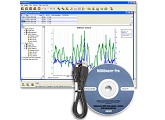February Newsletter - Data Loggers, What, Why and How....
| February Newsletter - Data Loggers, What, Why and How.... As per normal it has been a busy month around here at Instrument Choice. Apart from general instrumentation chit chat there has been a buzz around the office over recent weeks about the upcoming Adelaide Fringe Festival (www.adelaidefringe.com.au/) starting on the 24th February. Over the next month Adelaide city really does come alive with hundreds of wonderful unique performances and events. This month we will focus on Data loggers, you will get a general over view of what they can do and what applications they suit. We have a number of enquiries each week from customers who require data loggers but they are not sure about the specifications they require, we will also explain some of the jargon you will come across while researching data loggers, and make the process easier for you. Remember; if you have any questions regarding tests you need to conduct or specific instrumentation please give us a call. Until next month... Tyson Grubb |
- How frequently do you want to record information (the sampling rate)? - How much data do you wish to collect? - What accuracy and range do you need to measure? - Did you need to see the current readings in real time? What parameter/ parameters do you want to measure? Data loggers are able to record information (data) over time for display and analysis at a later point. Data loggers can record one or a number of different parameters depending on the unit, such as Temperature, Humidity, Conductivity, Depth, Events, GPS, Light, pH and Sound, just to name a few. How frequently do you want to record information (the sampling rate)? This essentially is how often the logger will take note of the condition you are trying to measure. Let’s say you want to record temperature in a room over 24 hours do you want the unit to record the temperature every 30sec or every 15mins? Sometimes this is determined for you, especially if you are trying to conform with a regulation as these can often state how regularly a sample needs to be taken, otherwise we can advise you on the optimum sampling interval for what you are trying to record. How much data do you wish to collect? The memory size needs to be considered so you can determine the memory size you need. The amount of data a unit can hold is usually written in the product information as a certain number of readings. You can work out how long you can record for by dividing the memory size by the number of samples recorded per hour. For example, if you recorded data every 5 minutes then you would be recording 12 samples per hour, a data logger which records 8000 readings would be able to record for 666 Hours (27.77 Days). Using this formulae you can make sure you data logger is able to hold the amount of information you want to collect. Now that you know what parameter/s you want to measure, how frequently you need the logger to sample which in turn led us to work out the memory size you require we can now narrow down the loggers to suit your application. Will the unit be able to be connected to a computer to download the information, or will the logger need to transmit the data wirelessly? Data loggers can connect to your computer in a range of ways, the most common is using the USB port to download after the recordings have been taken. In some applications you may not be able to retrieve the logger for downloading (ie. within sensitive environments) whilst other loggers form part of a larger system which would be impractical to retrieve to download the data (i.e. a large warehouse), in these cases it would be best to use a wireless data logger which can transmit data back to a convenient location. You may need a download kit or software If you are going to be able to retrieve the logger for down load then there are a number of different options including built USB connectors where you just plug the logger straight into your computer and away you go. It is always good to ask if you will need to purchase any software or download cables for the logger. These are often included with the logger but some units require them to be purchased separately. Our staff can direct you to any required accessories if they are need. There are a number of other questions you can ask yourself when considering the purchase of a data logger, we won’t go into too much detail about them here as one can only hold concentration on such a topic for so long. So if you are still reading, some other things to consider are; - Will the logger be getting wet/ exposed to the elements or need to be ultra durable? - Are you going to want to set alarms so the logger will beep or notify you when the parameter has gone outside a set off limits? So hopefully you are now well versed on the questions to ask when considering what data logger is best suited to your application. If in fact I have just made it as clear as mud then call us on 1300 737 871 to speak to someone who will know exactly what you need | |||

